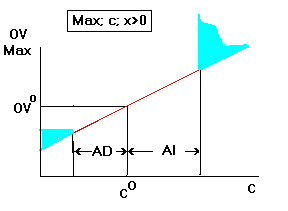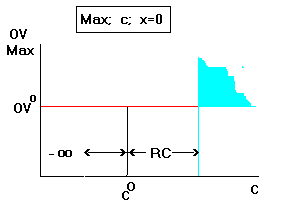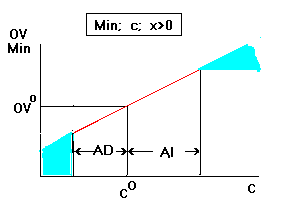 The OV increases at a rate equal to the value of the variable.(2)
When the change exceeds the AI, the solution changes in a way to
increase the value of the variable (7). Therefore further changes
in the OFC will increase the OV at a higher rate (blue area on
the right) (2). Likewise, if the OFC is reduced beyond AD, the
value of the variable will be reduced (7) and the OV will decline
at a reduced rate (blue area on the left) (2).
The OV increases at a rate equal to the value of the variable.(2)
When the change exceeds the AI, the solution changes in a way to
increase the value of the variable (7). Therefore further changes
in the OFC will increase the OV at a higher rate (blue area on
the right) (2). Likewise, if the OFC is reduced beyond AD, the
value of the variable will be reduced (7) and the OV will decline
at a reduced rate (blue area on the left) (2). go back
 Since the value of the variable is zero the OV does not respond
to the changes in the OFC (2). If the OFC is reduced, it makes it
even more unattractive and hence it will never become positive.
However, if the OFC is increased by the amount of the reduced
cost (RC), the variable will become positive (5) and further
increases in the OFC will increase the OV at this positive rate
(blue area on the right)(2).
Since the value of the variable is zero the OV does not respond
to the changes in the OFC (2). If the OFC is reduced, it makes it
even more unattractive and hence it will never become positive.
However, if the OFC is increased by the amount of the reduced
cost (RC), the variable will become positive (5) and further
increases in the OFC will increase the OV at this positive rate
(blue area on the right)(2).go back
 As the OFC increases the OV increases at a positive rate equal to
the value of the variable (2). When the increase exceeds the AI,
the solution changes, the value of the variable is reduced (7).
Thus beyond this point the OV increases at a slower rate (blue
area on the right) (2). When the OFC decreases so does the OV.(1)
When the AD is reached the solution changes in a way to increase
the value of the variable (7). Thus beyond this point, the OV
will decline even at a faster rate (Blue area on the
left)(3).
As the OFC increases the OV increases at a positive rate equal to
the value of the variable (2). When the increase exceeds the AI,
the solution changes, the value of the variable is reduced (7).
Thus beyond this point the OV increases at a slower rate (blue
area on the right) (2). When the OFC decreases so does the OV.(1)
When the AD is reached the solution changes in a way to increase
the value of the variable (7). Thus beyond this point, the OV
will decline even at a faster rate (Blue area on the
left)(3).go back
 The variable is too expensive, so the optimal solution has its
value at zero. It can become even more expensive without bound
and its value will stay at zero. If, on the other hand, its OFC
is reduced and it became less expensive by at least the amount of
its reduced cost, it may become positive (5). At this time
further reduction in its cost will improve (reduce) the OV (blue
area on the left.) (3)
The variable is too expensive, so the optimal solution has its
value at zero. It can become even more expensive without bound
and its value will stay at zero. If, on the other hand, its OFC
is reduced and it became less expensive by at least the amount of
its reduced cost, it may become positive (5). At this time
further reduction in its cost will improve (reduce) the OV (blue
area on the left.) (3)go back